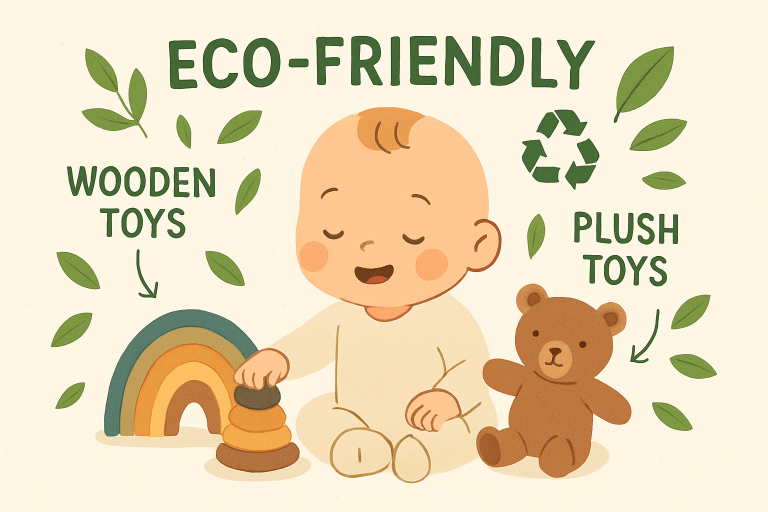As today’s parents become more environmentally conscious, making thoughtful choices for their children has extended well beyond nutrition and clothing. The demand for sustainable, non-toxic playthings continues to rise, with many families expanding their eco-friendly approach from baby clothes to toys and beyond. Selecting eco-friendly baby toys isn’t just about creating a safer play environment—it’s also a powerful way to reduce your family’s ecological footprint while prioritizing long-term well-being.
Eco-friendly baby toys, crafted from renewable resources such as organic cotton, bamboo, and recycled plastic, embody the intersection of safety, durability, and environmental stewardship. These choices benefit our planet, the health of our children, and the future they will inherit.
Table of Contents
Why Choose Eco-Friendly Baby Toys?
Conventional toys made predominantly from plastic and synthetic compounds not only present potential health hazards to children—with chemicals like phthalates, BPA, and lead—but also significantly contribute to global pollution and landfill waste. By switching to eco-friendly baby toys, parents can offer their little ones products made from natural, biodegradable, or recycled materials, often tested and certified to exclude harmful substances. This mindful choice protects developing immune systems while ensuring that environmental impacts from manufacturing, usage, and disposal are minimal.
Moreover, opting for sustainable playthings communicates important values to children from a young age: care for the environment, smart consumption, and a preference for quality over quantity. This aligns with a broader movement in parenting that emphasizes healthful, thoughtful choices across all aspects of a child’s upbringing.

Top Materials Used in Sustainable Toys
- Organic Cotton: Grown without the use of harmful pesticides or synthetic fertilizers, organic cotton is among the safest and softest materials for plush toys and baby dolls. Its hypoallergenic nature makes it perfect for babies’ sensitive skin, and it is fully biodegradable, reducing end-of-life waste.
- Bamboo: As one of the fastest-growing plants on Earth, bamboo is a renewable superstar. It’s durable, naturally antibacterial, and requires minimal water and pesticides during cultivation. Toys made from bamboo balance sturdiness with a pleasing natural aesthetic.
- Recycled Plastics: By repurposing post-consumer plastics—like milk jugs—into sturdy toys, manufacturers dramatically reduce the need for new plastic production and keep reusable materials out of landfills. These toys are easy to clean, exceptionally tough, and, when made responsibly, free from toxins like BPA or phthalates.
- Rubberwood: Harvested from mature rubber trees that have ceased latex production, rubberwood offers a sustainable, eco-conscious alternative to traditional hardwoods. It delivers a smooth finish ideal for toys without contributing to deforestation.
Leading Brands in Eco-Friendly Baby Toys
A growing roster of brands specializes in sustainable toys designed for babies and toddlers. These industry leaders combine thoughtful design, ethical sourcing, and safety-first standards:
- PlanToys: This pioneering company uses chemical-free rubberwood, water-based dyes, and non-formaldehyde glues. It is committed to minimizing environmental impact and advancing educational play with its beautiful, long-lasting products.
- Green Toys: Green Toys is known for producing toys from 100% recycled plastic (mainly milk jugs), and it puts landfill diversion at the heart of play. Their products are sturdy, dishwasher safe, and totally non-toxic.
- Lovevery: Offering developmentally appropriate, Montessori-inspired toys, Lovevery uses FSC-certified wood and organic cotton. Their subscription boxes encourage holistic, sustainable development.
Benefits of Sustainable Toys for Child Development
Eco-friendly baby toys often feature minimalist designs, allowing open-ended exploration rather than predetermined functions. This approach sparks imagination, creativity, and problem-solving skills. Natural materials like wood and organic textiles—compared to slick, unyielding plastics—offer tactile diversity, fostering fine motor development and sensory learning. The robust nature of these sustainable toys also means they rarely break, making them excellent for hand-me-downs or sharing among siblings. This longevity ultimately contributes to a culture of reuse, frugality, and environmental respect from a young age.
How to Identify Genuine Eco-Friendly Toys
As marketers increasingly adopt “green” buzzwords, it’s important to differentiate truly sustainable toys from clever packaging. Look for third-party certifications: the Forest Stewardship Council (FSC) label guarantees responsible management of forests for wood toys, while the Global Organic Textile Standard (GOTS) certifies organic fibers. Investigate brands’ manufacturing processes, supply chain transparency, and statements regarding chemical safety. Honest disclosure, verifiable certifications, and consistent commitment to ethical practices signify a brand you can trust.
The Future of Eco-Friendly Toys
The market for sustainable baby and children’s toys is expanding rapidly. According to industry analysts, global sales are projected to soar from $1.2 billion in 2024 to over $3.5 billion by 2028, as parents increasingly prioritize the health of their children and the environment. This growth signifies not only changing consumer preferences but also an industry-wide shift towards sustainable innovation.
In choosing eco-friendly baby toys, families invest not only in their child’s developmental journey but also in a cleaner, greener future. These thoughtful decisions echo forward, setting the stage for a safer, more sustainable world for generations to come.


